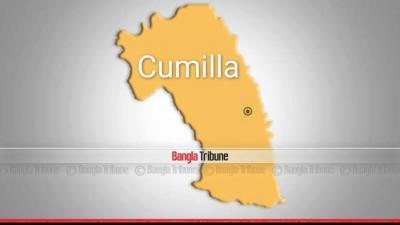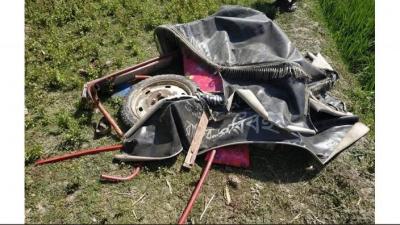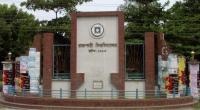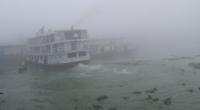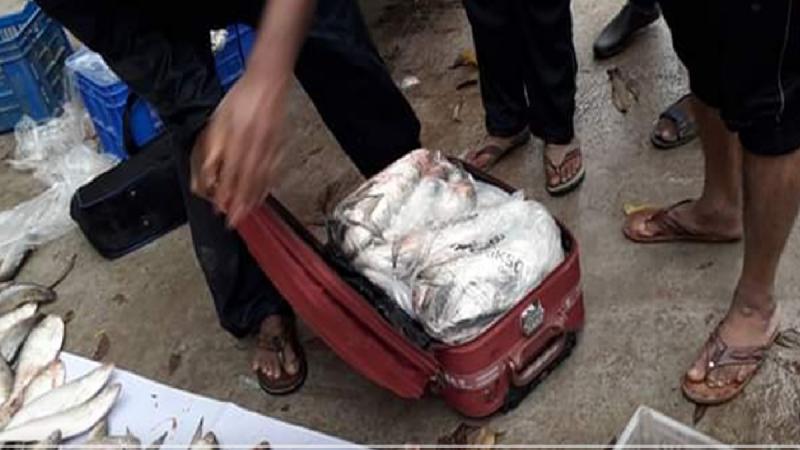 Despite the breeding season ban on catching Hilsha, trading of this fish hasn’t really stopped. Fishermen are managing to evade the administration’s watch and catching Hilsha in the Padma and Jamuna rivers. To avoid being caught for violating the van, they have come up with innovative strategies to sell and transport fish. Such a ploy was uncovered on Friday when Shibaloy upazila nirbahi officer Mehedi Hasan seized a huge amount of Hilsha in a variety of bags which are not used for fish transport, including travel luggage, sacks and even school bags.
Despite the breeding season ban on catching Hilsha, trading of this fish hasn’t really stopped. Fishermen are managing to evade the administration’s watch and catching Hilsha in the Padma and Jamuna rivers. To avoid being caught for violating the van, they have come up with innovative strategies to sell and transport fish. Such a ploy was uncovered on Friday when Shibaloy upazila nirbahi officer Mehedi Hasan seized a huge amount of Hilsha in a variety of bags which are not used for fish transport, including travel luggage, sacks and even school bags.
Acting on a tip-off, the upazila administration raided an engine-propelled boat on the waterways at Char-Shibaloy and seized nearly 200kgs of Hilsha in possession of traders in the guise of passengers.
The confiscated fish has been distributed among orphanages and madrasas, said Hasab before adding that the arrested fishermen have been sentenced to 5-year jail term.
Rafiqul Alam, senior fisheries official at Shibaloy Upazila said that boats used for catching Hilsha and 200,000 cubic meter of electric net have been destroyed.
On Sept 23, government imposed a ban on catching hilsha during its breeding season from Oct 7 to 28, across a vast area of 7,000 square kilometers along with twenty-seven districts in the country.
The ban came following a meeting of the ministry of fisheries and livestock on 'Mother Hilsha Saving Drive-2018' with state minister for fisheries, Narayon Chandra Chanda, in the chair. The government also banned procurement, marketing, buying, selling, transporting and hoarding of Hilsha during this period. Bangladesh produced over 500,000 tonenes of hilsa fishes in 2017-18 fiscal with hilsha contributing 1.15 percent to its GDP.
Hilsa accounts for 12 percent of the South Asian country’s fish production, which translates to around Tk. 75 billion. With a 9-10 percent growth in annual production, Bangladesh is the biggest source of hilsa, locally known as Ilish, followed by neighbouring India and Myanmar.
Among 11 countries around the world where hilsa is found, only Bangladesh witnessed a rise in production of the dazzling silver creature.
Hilsha is mainly a sea species but prefers to lay its eggs in rivers due to less salinity current. It is caught in all major Bangladeshi rivers, such as the Padma, Meghna and Jamuna, and their Bay of Bengal estuary.
Around half a million people in the coastal areas are involved in Hilsha fishing and over another 2 million are involved in processing, transporting, marketing and export across Bangladesh.
 Country
Country
31011 hour(s) 36 minute(s) ago ;
Evening 10:30 ; Tuesday ; Apr 30, 2024
Hilsha in school bag!
Send
Manikganj Correspondent
Published : 04:00, Oct 15, 2018 | Updated : 04:00, Oct 15, 2018
Published : 04:00, Oct 15, 2018 | Updated : 04:00, Oct 15, 2018
0 ...0 ...
/hm/tf/
Topics: Top Stories
- KOICA donates medical supplies to BSMMU
- 5 more flights to take back British nationals to London
- Covid19: Rajarbagh, Mohammadpur worst affected
- Momen joins UN solidarity song over COVID-19 combat
- Covid-19: OIC to hold special meeting
- WFP begins food distribution in Cox’s Bazar
- WFP begins food distribution in Cox’s Bazar
- 290 return home to Australia
- Third charter flight for US citizens to return home
- Dhaka proposes to postpone D8 Summit
Unauthorized use of news, image, information, etc published by Bangla Tribune is punishable by copyright law. Appropriate legal steps will be taken by the management against any person or body that infringes those laws.
Bangla Tribune is one of the most revered online newspapers in Bangladesh, due to its reputation of neutral coverage and incisive analysis.
F R Tower, 8/C Panthapath, Shukrabad, Dhaka-1207 | Phone: 58151324; 58151326, Fax: 58151329 | Mob: 01730794527, 01730794528

